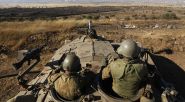
The Israeli army opened fire from its positions in Maskaf Aam, targeting a team from Al-Mayadeen news channel as their car was crossing the Odaisseh road. Their vehicle was hit by bullets, with no reported injuries.
This is not the first time Israel has targeted media personnel in southern Lebanon. On November 21, two journalists, Farah Omar and Rabih Maamari from Al-Mayadeen, were killed by Israeli fire, while Reuters reporter Issam Abdallah was killed on October 13.
In addition, the Hebrew state targeted and shot at workers repairing the electricity network in the border area, with no reported casualties.
Israeli artillery shelling hit the outskirts of Khiam, Hula, and Markaba towards Wadi Hunin. In the afternoon, Israeli reconnaissance aircraft flew intensively over Tyre and Bint Jbeil. Furthermore, Israel raided Wadi Hanine in the Bint Jbeil district, as well as Taybeh and Aita al-Shaab.
In retaliation, Hezbollah said in a statement that it had targeted Maskaf Aam with appropriate weapons, hitting it directly.
According to Israeli media, alarm sirens sounded in Maskaf Aam and Margaliot in northern Israel.
In the early evening, interceptor missiles exploded over Hamames, while three thermal balloons were observed in the skies over Zahrani, specifically over the town of Sarafand (Kouroum region).
Simultaneously, Israeli reconnaissance aircraft flew over Beirut.
Hezbollah announced that it had targeted Israeli artillery positions in Zaoura with dozens of Katyusha rockets, in retaliation for attacks on villages and civilian homes in the south, notably those of Taybeh and Aita al-Shaab.
Similarly, Hezbollah claimed responsibility for attacks on the Israeli sites of Miskaf Aam, Rweissat al-Alam and Sammaka (Kfarchouba hills), Al-Marj, as well as Karantina Hill.
According to Israeli media, 50 missiles were fired from Lebanon towards the Upper Galilee (northern Israel) in the evening.
Earlier in the day, alarm sirens sounded in Miskaf Aam and Margaliot in northern Israel.
The Israeli army announced that it had intercepted two Hezbollah drones in northern Israel.
This is not the first time Israel has targeted media personnel in southern Lebanon. On November 21, two journalists, Farah Omar and Rabih Maamari from Al-Mayadeen, were killed by Israeli fire, while Reuters reporter Issam Abdallah was killed on October 13.
In addition, the Hebrew state targeted and shot at workers repairing the electricity network in the border area, with no reported casualties.
Israeli artillery shelling hit the outskirts of Khiam, Hula, and Markaba towards Wadi Hunin. In the afternoon, Israeli reconnaissance aircraft flew intensively over Tyre and Bint Jbeil. Furthermore, Israel raided Wadi Hanine in the Bint Jbeil district, as well as Taybeh and Aita al-Shaab.
In retaliation, Hezbollah said in a statement that it had targeted Maskaf Aam with appropriate weapons, hitting it directly.
According to Israeli media, alarm sirens sounded in Maskaf Aam and Margaliot in northern Israel.
In the early evening, interceptor missiles exploded over Hamames, while three thermal balloons were observed in the skies over Zahrani, specifically over the town of Sarafand (Kouroum region).
Simultaneously, Israeli reconnaissance aircraft flew over Beirut.
Hezbollah announced that it had targeted Israeli artillery positions in Zaoura with dozens of Katyusha rockets, in retaliation for attacks on villages and civilian homes in the south, notably those of Taybeh and Aita al-Shaab.
Similarly, Hezbollah claimed responsibility for attacks on the Israeli sites of Miskaf Aam, Rweissat al-Alam and Sammaka (Kfarchouba hills), Al-Marj, as well as Karantina Hill.
According to Israeli media, 50 missiles were fired from Lebanon towards the Upper Galilee (northern Israel) in the evening.
Earlier in the day, alarm sirens sounded in Miskaf Aam and Margaliot in northern Israel.
The Israeli army announced that it had intercepted two Hezbollah drones in northern Israel.
Read more



Comments